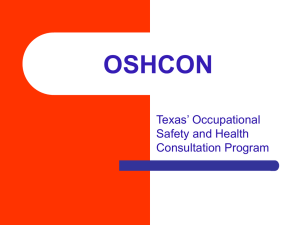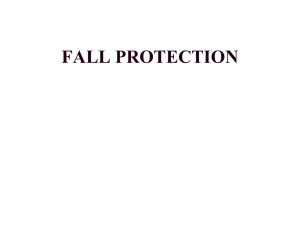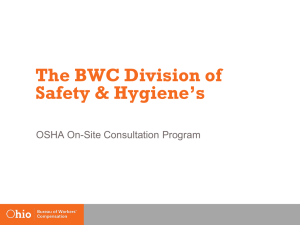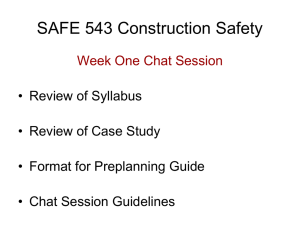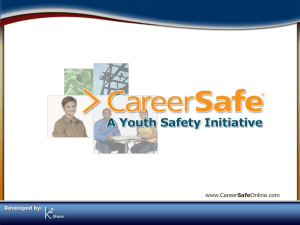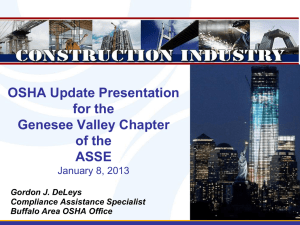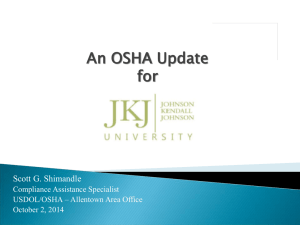Classic Template
advertisement
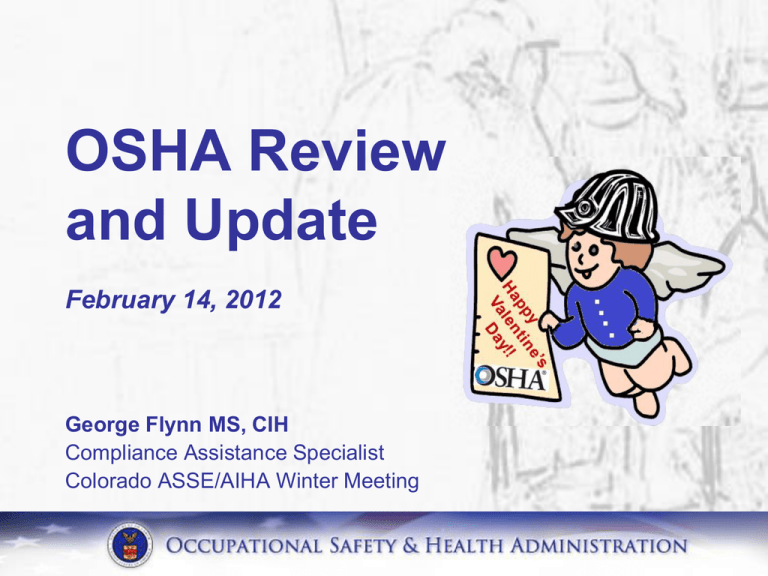
OSHA Review and Update February 14, 2012 George Flynn MS, CIH Compliance Assistance Specialist Colorado ASSE/AIHA Winter Meeting Region 8 Year in Review* • 53 Fatalities (57 in FY10) • 2164 Inspections – 83% Safety & 17% Health – 56% Construction • 2,293 Violations – – – – $4,834,435 proposed penalties 71% w/ informal conferences 41% penalty reduction 8.4% contested (4.2% in FY10) *Data for most compliance measures available only to mid-year Colorado Fatalities (2004-2012) 35 30 25 Total Construction General Industry Oil/Gas 20 15 10 5 0 2005 2007 2009 2011 Region 8 Year in Review* • 7 “Significant” Cases (ie, >$100K) – $1,512,655 initial proposed penalties – 3 Grain Handling Facilities • One involved non-fatal engulfment w/ proposed penalty of $378K – 2 Wind Energy Industry • Fatality at wind tower manufacturer • Stryene overexposures, PPE and Conspace at wind blade manufacturer – 1 Federal Agency • More than 25 overexposures and numerous PSM – 1 SST, Chemical/Recordkeeping NEP • Numerous PSM *Data for most compliance measures available only to mid-year Criminal Cases Resolved in 2011 • 2007 Fire at Xcel Energy’s Cabin Creek Hydroelectric Plant – 5 RPI workers were killed in the fire • Xcel Acquitted • RPI Pleads Guilty on Dec. 20th – 5 years probation and $1.55 million fine paid to family members of the victims – OSHA fine reduced to $100K Criminal Cases Resolved in 2011* *CSB Investigation Report – 8/25/2010 Criminal Cases Resolved in 2011 • 2009 Tempel Grain Engulfment – Cody Rigsby, age 17, died of suffocation – $1.6 million fine proposed – 5 years probation and $500K fine paid to family members of the victim – OSHA fine reduced to $50K OSHA Frequently Cited Violations (October 1, 2010 to September 30, 2011)* 1. Fall protection in construction (1926.501): 7,139 violations; 260 worker deaths in FY10 due to violations of this standard (BLS) 2. Scaffolding in construction (1926.451): 7,069 violations; 37 worker deaths in FY10 from incidents involving scaffolding (BLS) 3. Hazard communication (1910.1200): 6,538 violations 4. Respiratory protection (1910.134): 3,944 violations 5. Lockout/tagout (1910.147): 3,639 violations 6. Powered industrial trucks (1910.178); 3,432 violations; 8,410 injuries in FY10 connected to use of PITs (BLS) 7. Ladders in construction (1926.1053): 3,244 violations 8. Electrical wiring methods (1910.305); 3,584 violations 9. Electrical general requirements (1910.303): 2,863 violations 10. Machine guarding (1910.212): 2,748 violations *Patrick Kapust; Deputy Director fo Enforcement Programs; NSC presentation OSHA Top 10 Willful Violations (October 1, 2010 to September 30, 2011) 1. Excavation, Protective Systems 2. Fall Protection 3. Grain Handling Facilities 4. Process Safety Management 5. Asbestos 6. Recordkeeping, Gen’l Recording Criteria 7. Lockout/Tagout 8. Safeguards for Personnel Protection 9. Lead 10. Recordkeeping, Recording Criteria Relative Ranking of 10 Most Frequently Cited Construction Standards* Movers *Draft OSHA Publication 100 Most Frequently Cited Physical Construction Standards in 2010 by Subpart* *Draft OSHA Publication Magnifying the Impact of Inspections • • • • Publicity Corporate-wide actions Interagency Cooperation Severe Violators Enforcement Program – Return inspections – Expanded scope OSHA “Word of the New Year” Recidivist – n. one who lapses into previous undesirable patterns of behavior OSHA “Phrase of the New Year” “Enterprise-wide remedy/relief” DOJ Worker Safety Initiative DOJ Worker Safety Initiative • Denver Training Conducted in 2011 – OSHA Regional and Area Office staff, Regional Solicitor of Labor, EPA Region 8 and the U.S. Attorney’s Office. – DOJ presented on: • achieving worker safety through prosecution of environmental crimes • cases and information DOJ interested in for potential referral – Training has resulted in one referral to EPA Severe Violator Program (SVEP) • Criteria 1 - Fatality/Catastrophe • • • 1 or more serious violations classified as W,R or FTA & related to the death 3 or more hospitalizations Criteria 2 - High Emphasis Hazard • 2 or more W,R or FTA (or any combination thereof) based on high gravity serious violations • High Emphasis Hazards • • • • • • • Falls in GI & Construction Amputations Combustible Dust Silica Lead Trenching Grain (Recently Added) Severe Violator Program (SVEP) • Criteria 3 - PSM • • 3 or more W,R or FTA (or combo) based on high gravity serious violations due to potential release of a highly hazardous chemical Criteria 4 – Egregious • All egregious cases (ie, instance-byinstance penalties) SVEP Statistics (thru July 2011) • National • 174 cases • 63% Construction (109 of 174) • 21% Fatality-related (36 of 174) • Region 8 • 5 cases • 20% Construction (1 Case) • 60% Fatality-related (3 of 5) Significant Enforcement Cases (ie, >$100K) on the Rise 250 199 200 195 170 165 150 150 127 50 120 123 103 100 57 27 61 164 140 107 101 108 121 120 69 27 0 90 Y91 Y92 Y93 Y94 Y95 Y96 Y97 Y98 Y99 Y00 Y01 Y02 Y03 Y04 Y05 Y06 Y07 Y08 Y09 Y10 FY F F F F F F F F F F F F F F F F F F F F Administrative Penalty Increase $2,500 $2,005 $2,000 $1,500 $1,000 $918 $998 $970 $1,053 $500 $0 FY07 FY08 FY09 FY10 FY11 OSHA Areas of Emphasis and Fall 2011 Regulatory Agenda Projects Completed or Nearing Completion • Standards Improvement Project III • Electric Power Generation, Transmission and Distribution • Hazard Communication/GHS • Walking Working Surfaces and Personal Fall Protection Completed or Nearing Completion • Standards Improvement Project (SIPs) III (Effective Date - 7/8/11) – Final Provisions expected to result in: • Savings of $45 million per year and 1.85 million fewer hrs of paperwork – Final provisions include: • • • • Changes to EPA definition of potable water Eliminates transfer of records to NIOSH Updates Means of Egress Provisions Removes outdated requirement that hand dryers use warm air • Amends the slings standard to remove outdated tables specifying loads • Requires that employers only use slings (incl. wire rope) marked with manufacturers’ loading information Completed or Nearing Completion • Electrical Power Generation, Transmission and Distribution (Final Rule was planned for Sept. 2011) OMB review – Update based on latest consensus standards – New provisions for contractor-host information exchange, protection from electric arcs, minimum approach distances, fall protection from aerial lifts Now Set for June 2012 • HazCom Global Harmonization (GHS) (Final Rule was planned for Sept. 2011) OMB review – Hazard classification: Specific criteria for classification of health and physical hazards and mixtures. (Issue?: “Unclassified hazards”) – Labels: Manufacturers and importers must provide label that includes a harmonized signal word, pictogram, and hazard statement for each hazard class and category. Precautionary statements must also be provided. – Safety Data Sheets: Specified 16-section format. Now Set for Feb. 2012 Completed or Nearing Completion • Walking & Working Surfaces; Personal Fall Protection Equipment (Subparts D and I) • Notice of Proposed Rulemaking – May 2010 • Comment period ended – April 2011 – Reflects changes in technology and improvements in industry work practices – Provides greater compliance flexibility for the mitigation of fall hazards – Reorganizes the rule in a clear, logical manner – Adds a section to Subpart I providing criteria for fall protection equipment • Next step: Analyze the record and develop the final proposal Regulatory Items Nearing Proposal • Silica – Completed peer review of the health effects and risk assessment – Submitted to OMB for review - February 2011 – Next step: Publish the NPRM – Issues: Scope, PEL, alternatives to exposure assessment PR now set for Feb. 2012 • Beryllium – Initiated peer review of the risk assessment and health effects - March 2010 – Peer review completed – November 2010 – Next step: • Peer review of economic analysis - May 2011 – Issues: PEL, use of the Beryllium Lymphocyte Proliferation Test (BeLPT), Scope Moved to “Longterm” Action Other Areas of Regulatory Emphasis • I2P2 – Stakeholder meetings held in 2010 – Small Business Regulatory Fairness Act (SBREFA) review - June 2011 Draft Text Release Feb. 2012? • Confined Space in Construction – Submitted to OMB for Review – Final Rule was planned for Nov. 2011 • Combustible Dust – Stakeholder meetings held in 2010 – SBREFA review – Dec. 2011 • Recordkeeping Now Set for June 2012 Moved to “Longterm” Action I2P2 Stakeholder Comments • The standards should be flexible yet enforceable • The standards should be simple yet detailed • Safety committees are effective, yet may run afoul of the NLRA • Management systems desirable, yet small businesses may not implement them • Make it a performance standard yet tell employers and compliance officers exactly what is required • Everyone should have a program, yet written programs tend to remain on the shelf Too Cold! Too Hot! Just right… https://www.osha.gov/dsg/topics/safetyhealth/index.html Recordkeeping – NAICS Update and Reporting Revisions • Proposed Rule - 6/22/11 • Comment period closed - 9/20/11 • New Rule Would: – Convert from SIC to NAICS – Update Partially Exempt List (App A) using more up-to-date injury and illness rates – Require reporting within 8 hrs of all workrelated in-patient hospitalizations (currently 3 or more) – Require reporting within 24 hrs of all workrelated amputations (ie, involving bone loss) • Next step: Review comments and promulgate final rule Recordkeeping – MSD Column • • • • • • • NPRM - 1/29/10 Public meeting - 3/9/10 Comment period closed - 3/30/10 Submitted to OMB - 6/16/10 Final rule temporarily withdrawn from OMB - 1/25/11 Special small business stakeholder teleconferences - 4/11-12/11 Record Re-opened 5/16/11 and closed 6/16/11 National Emphasis Programs • Trenching (1985) • Amputations (2006) – Under evaluation • • • • • Lead (Pb) (2008) Silica (2008) Combustible Dust (Reissued in 2008) Hexavalent Chromium (2010) Primary Metals (2011) National Emphasis Programs • Grain Handling (2011) – Includes letters to over 13,000 employers – Inclusion of Grain Handling Standard citations in SVEP Program • PSM Covered Chemical Facilities (2011) – Replaces the 2009 pilot – Finding same problems as in the refinery NEP • • • • Process hazard analysis Management of change Safety instrumented systems Training NEPs Under Consideration • Isocyanates • Nursing Homes • Cranes and Derricks – Developing the compliance directive – Developing compliance officer training Regional/Local Emphasis Programs • Falls in Construction REP • Oil and Gas Well Drilling and Servicing REP • Roadway Workzone Safety REP ---------------------------------------------------------• Asbestos (Englewood LEP) • Respirators/Noise (Englewood LEP) • Commercial Laundries (Englewood LEP) • Logging (Denver LEP) Industrial Hygiene Developments • IH Focus as part of OSHA’s operating plan – More industrial hygiene sampling – Focus on noise sampling, citation, and abatement of noise hazards – Focus on health hazard documentation and abatement of hazards – Focus on removal of workers from health related hazards Industrial Hygiene Developments • Working with OSHA Training Institute (OTI) to: – Develop more technical courses – Bring back the industrial hygiene courses – Re-train IH’s to do IH inspections – Re-establish the industrial hygiene branch or division at OTI PELs Update Project • Formation of internal OSHA taskforce in March 2010 to develop options for addressing OSHA’s outdated PELs • Stakeholder meeting 6/24/10 with invited experts across business, labor and academia Options Discussed • Substance-by-substance approaches • Control-based approaches • Policy/process approaches • Annotation of OSHA’s ZTables • Public forum to nominate chemicals of most concern PELs Web Forum • Web forum to nominate chemicals (Aug. 6-31, 2010) • 130+ comments • Top Vote Getters: – Isocyanates – Halogenated wastes – Manganese fume – Carbon Dioxide – Sulfuric acid – Mercury Animated Construction Videos http://www.osha.gov/dts/vtools/construction.html Respiratory Protection Videos http://www.osha.gov/video/respiratory_protection/index.html (Note: These are 200-500 MB mp4 files) Heat Safety Tool New mobile phone app provides critical information for reducing risk of heat illness during outdoor work osha.gov/SLTC/heatillness Calculates heat index for worksite location Displays “risk level” for work at that heat index Lists protective measures to reduce risk of heat illness Water ☼Rest ☼ Shade Of course WE liked it, but… “Pardon my French, but I really cannot stress how bad this application is. Firstly, it isn’t actually capable of the function it is supposed to do. When I first tried the application, it told me that it was currently 140F in Boston. It is also extremely slow, it looks like butt, and it crashes all the time. It is completely horrible in every way.” Rick Jones, Android App Developer Disclaimer This information has been developed by an OSHA Compliance Assistance Specialist and is intended to assist employers, workers, and others as they strive to improve workplace safety and health. While we attempt to thoroughly address specific topics, it is not possible to include discussion of everything necessary to ensure a healthy and safe working environment in a presentation of this nature. Thus, this information must be understood as a tool for addressing workplace hazards, rather than an exhaustive statement of an employer’s legal obligations, which are defined by statute, regulations, and standards. Likewise, to the extent that this information references practices or procedures that may enhance health or safety, but which are not required by a statute, regulation, or standard, it cannot, and does not, create additional legal obligations. Finally, over time, OSHA may modify rules and interpretations in light of new technology, information, or circumstances; to keep apprised of such developments, or to review information on a wide range of occupational safety and health topics, you can visit OSHA’s website at www.osha.gov.

